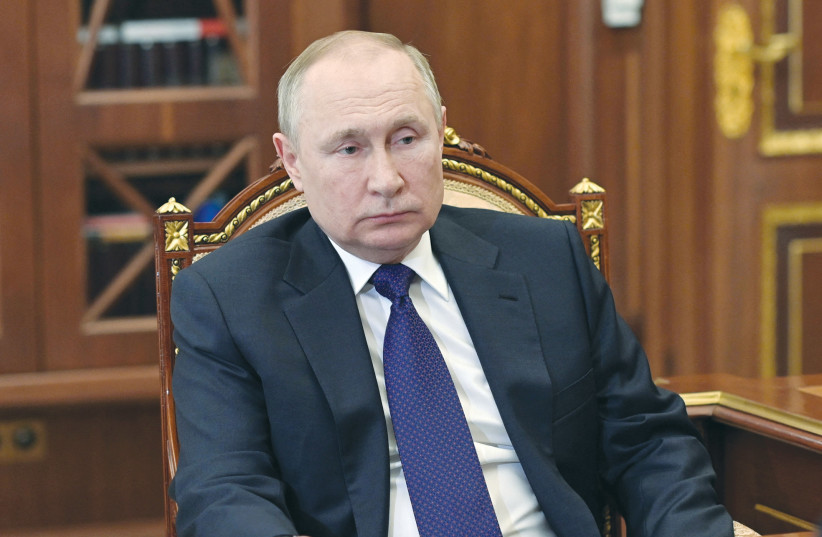As the war in Ukraine intensifies, it is crucial to recognize that the war, as horrific as it is, is only one step in the Russian strategy to challenge American world dominance. Meaning, there are more steps to come. This article will analyze the Russian reasoning, rationale and long-term strategy.
The Russian government led by Putin has carried a strong and proud national identity, accompanied with a deep sense of insult, and humiliation from the collapse of the Soviet Union and Moscow’s loss of its title as a superpower in a world of two superpowers, to one where the US dominates alone the world affairs.
These Russian sentiments are dangerous to such a proud nation. It must be recalled that Nazi Germany was the product of German sentiments of humiliation to the terms it was forced to accept at the onset of WWI. This is not to compare Russia to Nazi Germany, but as a reminder that such sentiments bread aspirations for vengeance.
Since his rise to power, Putin has worked relentlessly to sustain his power and turn his rule into a totalitarian one. His domestic success allowed Putin to begin his long-term campaign towards bringing Russia to the position of superpower, one that is rival to the US. Such a golden opportunity to challenge the US presented itself, in the form of the civil war in Syria.
The US attempted to take the lead in the Syrian war, as it sided with rebel groups that attempted to take down Assad. The US strategy in Syria was inconsistent, limited and lacked real American leadership on the battlefield. Moreover, the US and its allies were incapable of stopping the imminently expanding threat of ISIS, which gained massive territorial control and established the Islamic State.

Putin took advantage of the American failure and ordered an official military intervention in Syria in September 2015. By then, ISIS controlled large parts of Syria and Assad was on the brink of collapse. However, the Russian involvement turned the scale in Assad’s favor. Since ISIS was dismantled in Syria, controlling only small enclaves, Assad has regained control over most of Syria and has re-established his position as the one ruler of Syria.
Being historical allies, Assad publicly welcomed the Russian intervention and denounced the American interference in Syria. This statement by the leader of a state preferring Russian intervention over a US one was the first step in Russia undermining the position of the US. This act and the Russian success in keeping Assad in power shifted the balance of power and placed Russia back as an interventionist superpower that can interfere in other states’ crises, to its own interest.
Although the crisis in Crimea in 2014 preceded the official military intervention in Syria (September 2015), the intervention in Syria remains the catalyst that signified the Russian challenge to the US. Then, Moscow was shrewd to recognize American hesitance in aiding the Syrian rebels and their loss of control in facing the expanding Islamic State at the time.
His entrance and success granted him two key military bases in Syria: The Khmeimim airbase in Latakia and the seaport of Tartus (Russia’s first presence in the Mediterranean). Another challenge to US dominance. In this case, it is in the form of Russian military expansion in the Middle East.
Russia has realized that the West has simply accepted the hard fact that Russia has invaded Crimea, failed to respond and is proving divided on critical political and military dilemmas. This apparent divide, along with Russian assessment and recognition that the US will not respond militarily against Russia, led Putin to decide upon a military operation in Ukraine.
Putin’s assessment has proven thus far to be accurate. The West has settled on economic sanctions only against Russia and, despite harsh economic actions, the West proved its inability to act militarily. The Russian conclusion from the West’s behavior concerning Ukraine is: As long as the state in question is not a member of the EU or NATO, the West will not act militarily against Russian military operations in Eastern Europe.
Therefore, Russia will aim in the upcoming three to five years to undermine governments and states in Eastern Europe, with paid protest in support of Russia and Russian national identity, and massive social media campaigns using Bots in order to reshape ideas, opinions and perception. This will create the Russian pretext to invade other states in Eastern Europe.
This assessment suggests that the war in Ukraine is only one step towards the new world balance of power that Russia aspires towards. Russia will not pursue military operations against the West. However, it will expand its stronghold in Eastern Europe and create a new equation of an East block vis-a-vis the West, led by Russia, China and Iran.
There are only two factors that can affect or prevent this scenario. The first is Russian internal opposition or Western military action. Some voices have been heard from Russia against the ongoing war; however, protests alone will not stop Putin from achieving his aspirations. Only drastic internal struggle, one that will lead to a change of regime, will be effective against Putin’s Russia.
The other factor is the scenario in which the West loses its patience with Russia’s attitude and responds militarily. This scenario is extremely unlikely in the present war, but will be possible in the next country Putin invades in Eastern Europe, or the one after that. Only time will tell if any of these factors will come to exist, or whether we are going towards a new world order.
The writer has a master’s degree in national security studies from the University of Haifa International School and a BA in international relations from James Madison University in Virginia. He has been published as a researcher at the Alma Research and Education Center.
